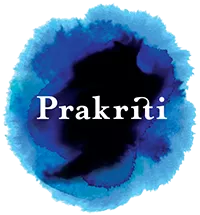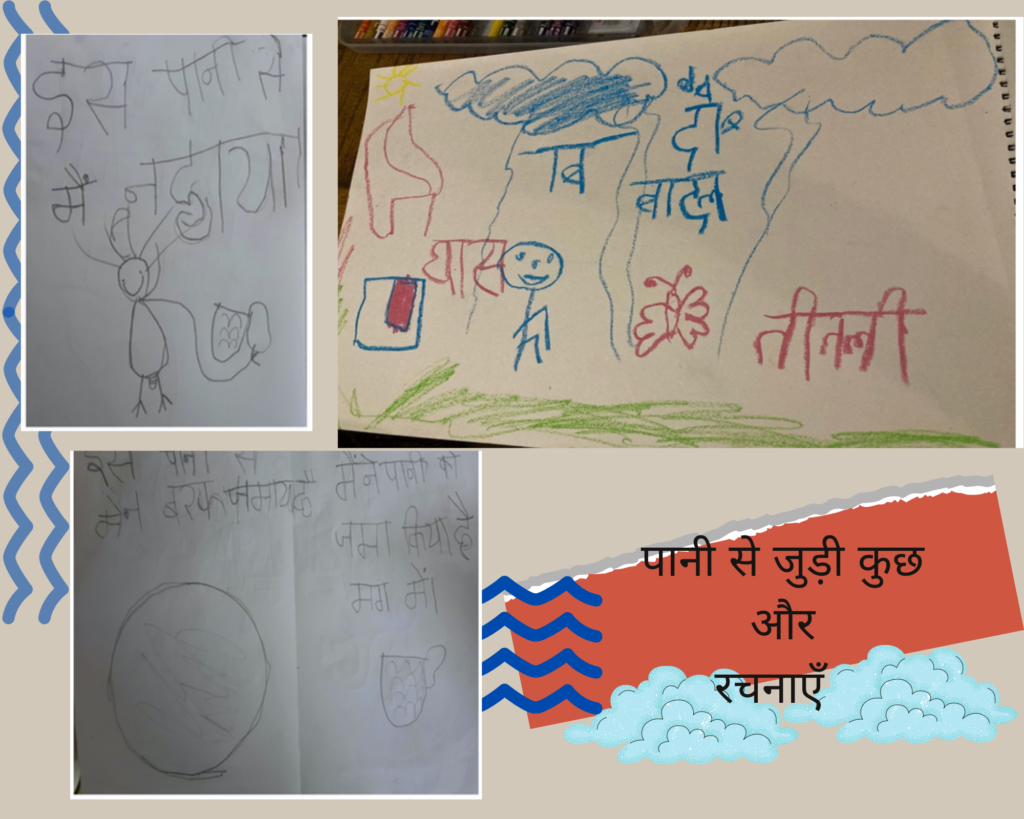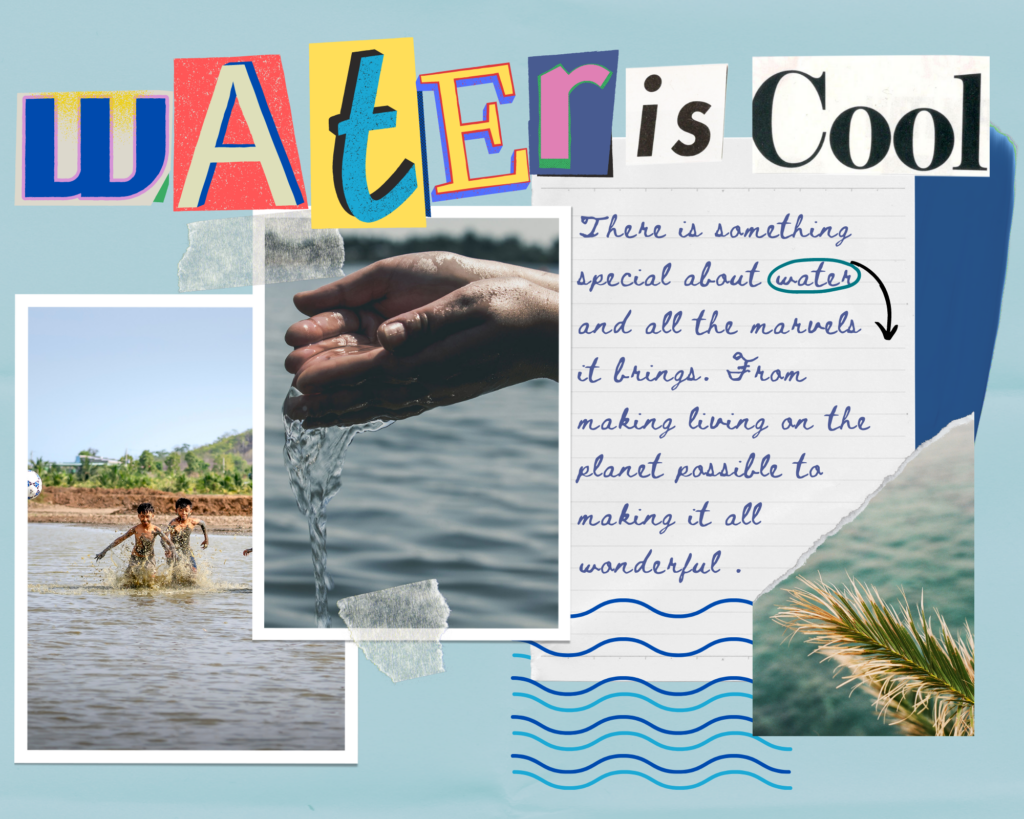
Thematic learning helps students draw connections from the real world by integrating fun learning activities inspired from surroundings (e.g. ecosystem, atmosphere etc.) The activities compel children to think, problem-solve, develop gross /fine motor skills while pushing their imaginations in a cooperative role-playing to understand concepts in independence
To deepen their understanding of the role of water in everyday lives, an authentic, fun-filled series of programs themed “Wonderful Water” was designed for the month. All streams of studies like language, mathematics, and arts were interlinked through various project tasks to enable them to showcase their understanding of the subject matter.
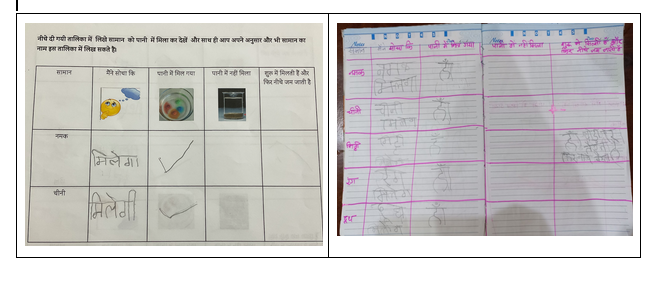
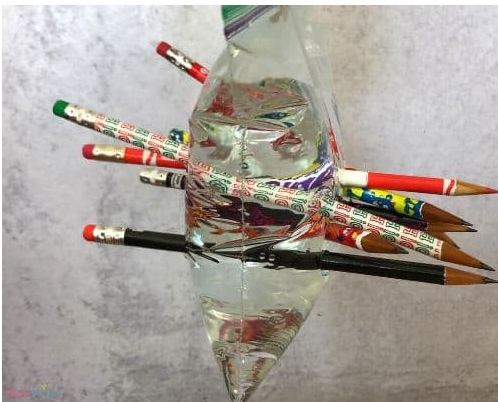 The theme started with a story “ सूरज गया पानी में ‘‘, a fun filled prose about the sun’s reaction when it comes in contact with water. Post session, children shared their own experiences and fun moments of playing with water on several occasions. They also undertook an activity of piercing pencils through a water-filled zip lock pouch and observed its flowing characteristics.They shared their understanding in correlation to the pursuit and experiences from everyday observations.
The theme started with a story “ सूरज गया पानी में ‘‘, a fun filled prose about the sun’s reaction when it comes in contact with water. Post session, children shared their own experiences and fun moments of playing with water on several occasions. They also undertook an activity of piercing pencils through a water-filled zip lock pouch and observed its flowing characteristics.They shared their understanding in correlation to the pursuit and experiences from everyday observations.
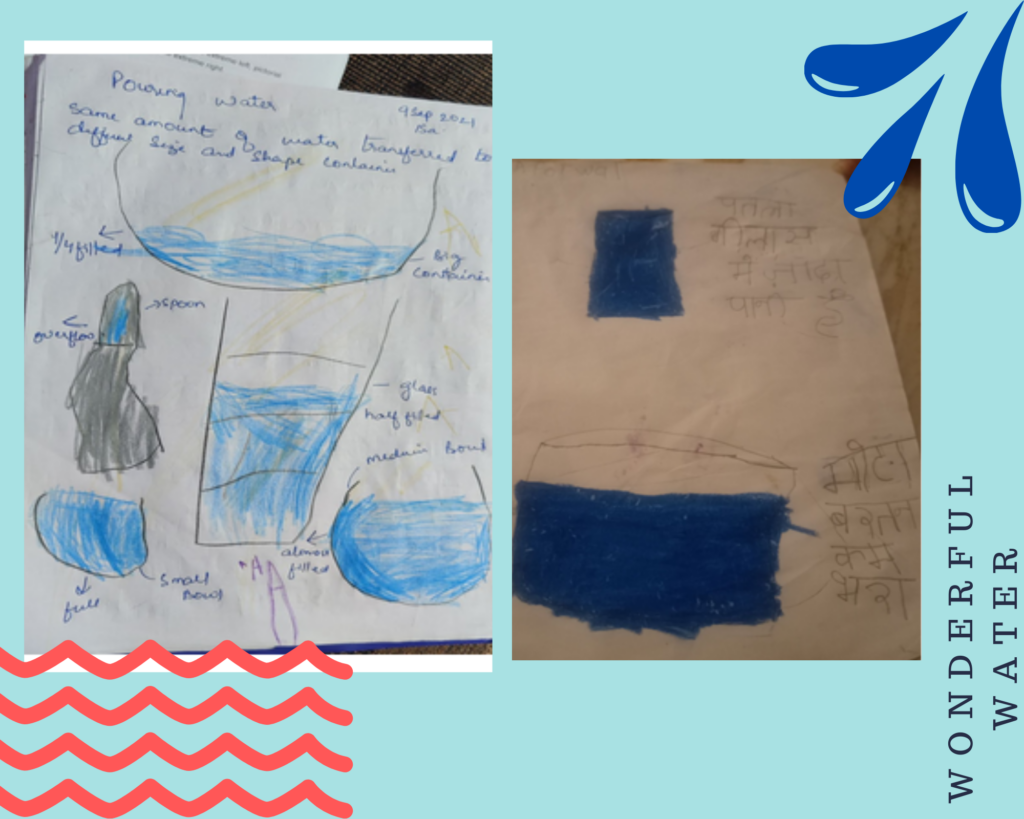
The fact that water is colorless was ascertained logically when they mixed various colors in water and found that water assimilates or assumes the color mixed in it.Similarly, they discovered that water is shapeless as it takes the shape of the vessel it is contained in. The students explored another feature of water which they experienced, as they prepared and tasted lemonade which helped them to come to the conclusion that water is tasteless
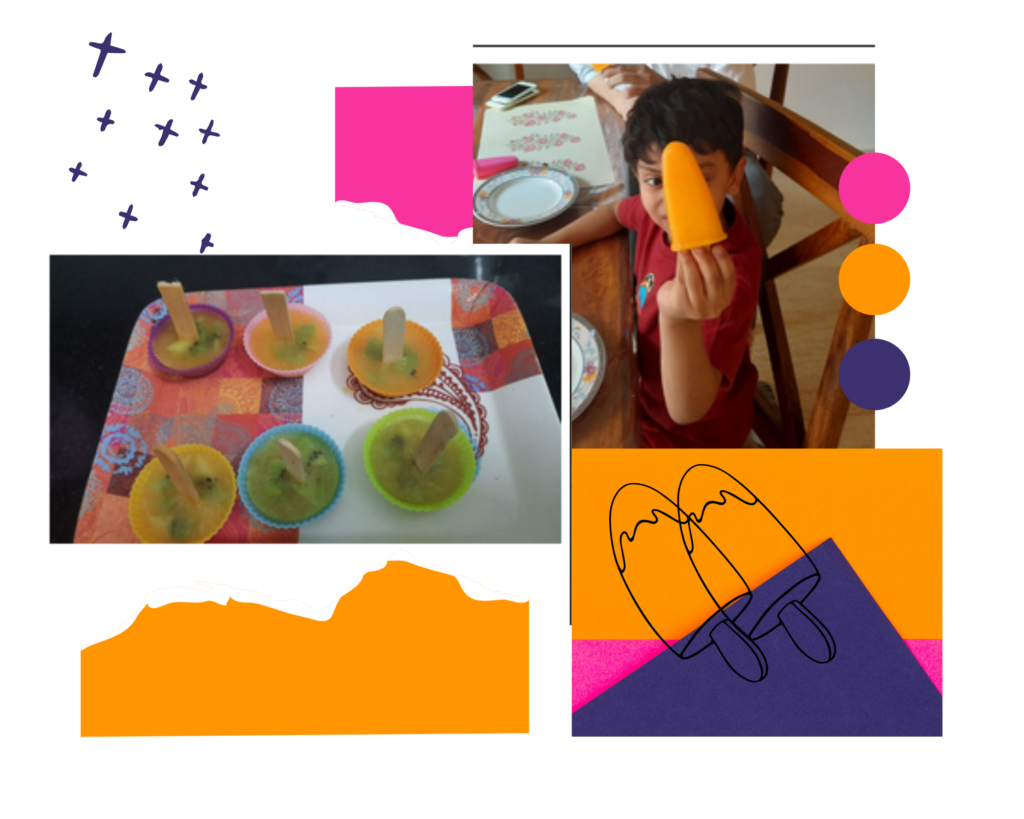 Their knowledge was further enhanced by knowing about various forms of water. For this, learners were given a task of making their own Fruit Ice Lollipop by crushing the fruits of their choice and putting them in an ice tray with water in the refrigerator. They observed that after a few hours the water and fruits were frozen and turned into a solid form. Learners enjoyed having their Fruit Lollipops and from their observations, they concluded that water has unique properties and can exist in different forms, i.e. solid, liquid and gaseous state.As a follow-up assignment, learners created a colored bubble mix to observe and report the key characteristics and behaviour of the bubbles formed. For example, the formation of bubbles was observed to be hollow white spheres with an iridescent surface.
Their knowledge was further enhanced by knowing about various forms of water. For this, learners were given a task of making their own Fruit Ice Lollipop by crushing the fruits of their choice and putting them in an ice tray with water in the refrigerator. They observed that after a few hours the water and fruits were frozen and turned into a solid form. Learners enjoyed having their Fruit Lollipops and from their observations, they concluded that water has unique properties and can exist in different forms, i.e. solid, liquid and gaseous state.As a follow-up assignment, learners created a colored bubble mix to observe and report the key characteristics and behaviour of the bubbles formed. For example, the formation of bubbles was observed to be hollow white spheres with an iridescent surface.
Questions regarding micro structures and structural coloration were also briefly discussed.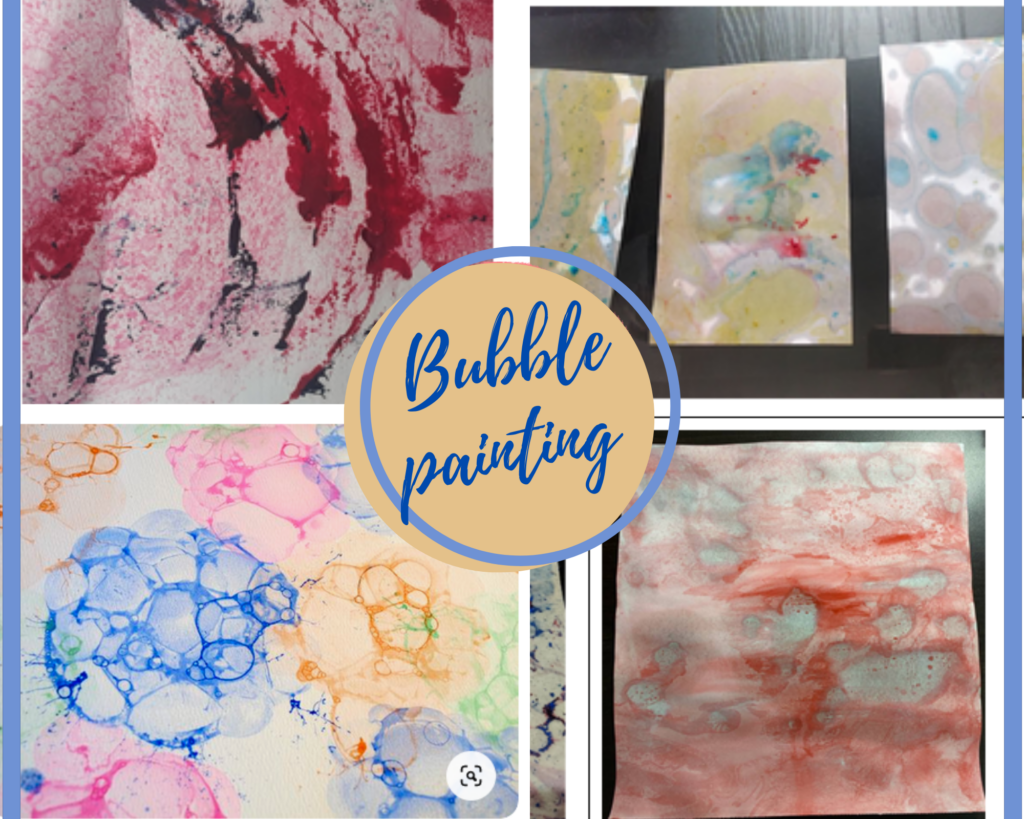 Image R.H.S is of Bubble Painting It encourages experimentation, creativity, and is lots of relaxing fun!
Image R.H.S is of Bubble Painting It encourages experimentation, creativity, and is lots of relaxing fun!
Learner’s were made conscious of varied uses of water around them in everyday activities like bathing, washing hands, cooking, washing utensils, cleaning floors etc. They learnt to appreciate the importance of water in their daily lives which followed the discussions around reusing and saving water. Learners offered various solutions that they would like to implement in their daily routine to save water and created books related to the same.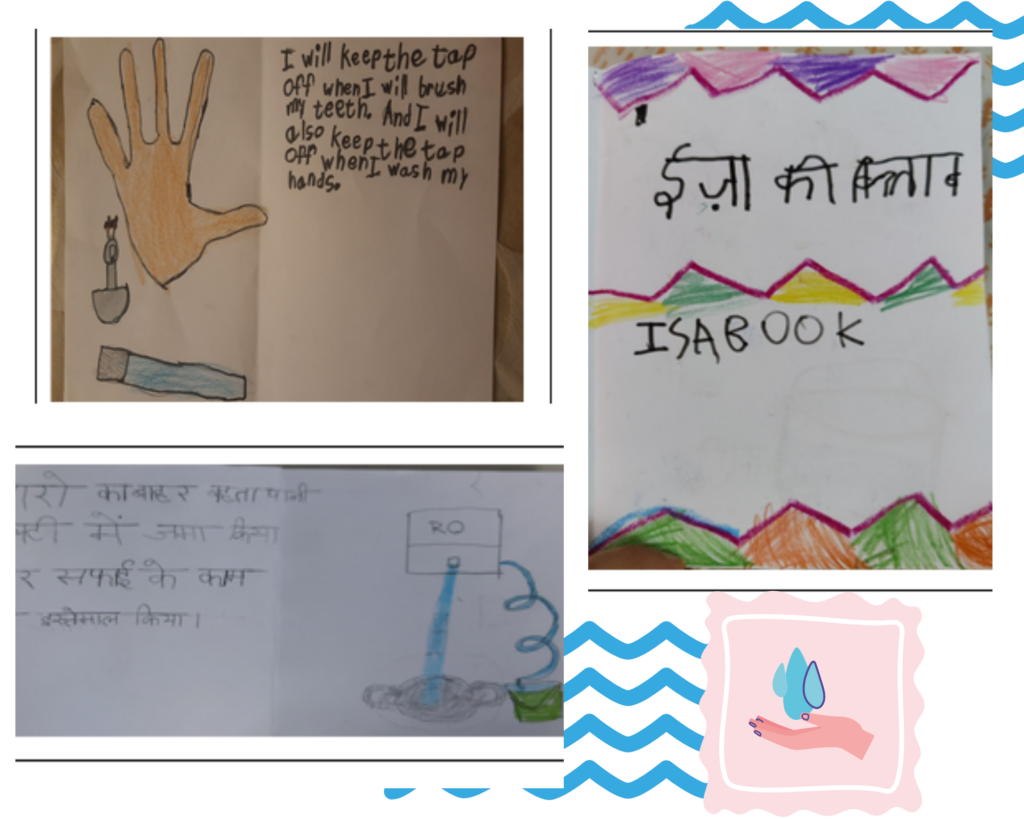

To continue the theme over the weekend , learners were encouraged to undertake simple experiments at home and document their observations to be presented during the school hours. The napkin siphon experiment was one to understand “Capillary action” in which interconnected fiber napkins bridging over several water filled glasses siphoned water from one glass to other due to gravity.Similarly, learners also did a“Walking Water ” experiment, where they filled half of their glasses with colored water and kept one empty glass in between two colored water glasses. They then kept tissue paper, one tissue paper in two glasses and observed the movement of water from one glass to the other through tissue papers.
Learners also got the opportunity to try hands in Paper Chromatography where they observed splitting of a color into various other colors when dipped in water and enjoyed the activity.

हिंदी भाषा की कक्षा वाले दिन भी, जल (पानी) थीम की शुरुआत एक उचित, आकर्षक और सुनहरे बरसात वाले दिन से हुई | जहाँ सभी के घरों के बाहर झमा-झम बरसात हो रही थी, वहीं बच्चों ने भी अपनी हथेली और उँगलियों की मदद से बारिश की आवाज़ बनाई | कैसे ? यहाँ बच्चों ने अपनी एक हाथ की हथेली को खोला, उसके बाद दूसरे हाथ की पहली ऊँगली ली और उसको हथेली पर मारा, फिर एक और ऊँगली ली, फिर एक और, और फिर एक, और ऐसे धीरे-धीरे करते हुए आवाज़ बढ़ती गई और कक्षा में भी झमा-झम बारिश का आनंद लिया गया |
‘पानी’ शब्द से बच्चों के मन में कौन-कौन से दृश्य आते हैं, इस बारे में भी चर्चा की गई | इस बात पर बच्चों के अनुभव कुछ इस प्रकार थे – झरना, मेंढ़क का पानी में कूदना, बारिश वाला गाना, पानी में उछलना, पानी को टपकते देखना, छाता, बरसाती, नाव, पूल पार्टी, छमछम, छपाक और भी बहुत कुछ | बच्चों ने ‘पानी’ (फिरकी) से जुड़ी एक कविता भी की और अपने घर और आस-पास, इस बात की भी खोज की कि पानी कहाँ-कहाँ पर है – और उन्होंने पाया – बोतल में, पानी की टंकी में, घड़े में, स्विमिंग पूल में और भी अन्य जगह | साथ ही साथ बच्चों ने पानी की तरह-तरह की आवाज़ को पहचाना, वह आवाज़ उन्हें कहाँ से आई, इस बारे में भी बताया | नीचे दिए गए चित्रों की तरह :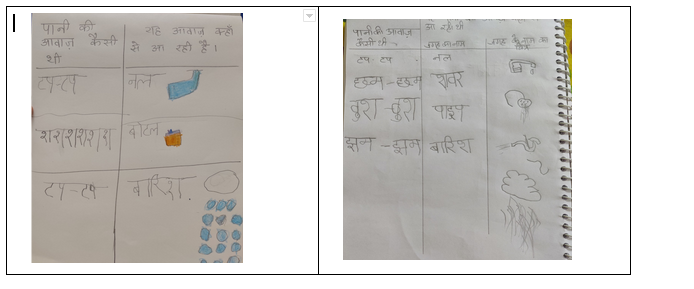
बरसात आए और अपने साथ तूफ़ान न लाए ? ऐसा कम देखने को मिलता है | और तूफ़ान जब आए तब घोंघा न दिखे ? यह नामुमकिन लगता है | एक तूफ़ान वाले दिन हमारी कक्षा में कहानी के रूप में आया था – “सुनुसुनु घोंघा-बगीचे में तूफ़ान” (तूलिका) —- आया ! आया ! सुनुसुनु आया – मेर्री ग्रुप से मिलने आया | तूफ़ान में हम सभी अपना बचाव करने के उपाय ढूंढते हैं | लेकिन कैसे ? आइए देखते हैं कुछ रचनाएं हमारे दोस्तों द्वारा:बरसात आए और कश्ती का गीत न गाया जाए और कश्ती को पानी में तैराया न जाए ! क्या ऐसा हो सकता है ? नहीं न ? दोस्तों ने सुंदर-सुंदर कश्तियां बनाने के बाद; डगमग-डगमग हो के, कभी इधर तो कभी उधर जा के – ‘एक छोटी कश्ती मेरे पास ‘ कविता क
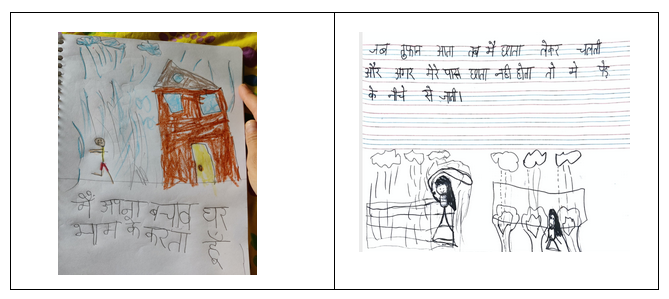
बरसात के दिनों में बादल भी दिलचस्प और तरह-तरह के रूपों में दिखाई देते हैं – काले और घने, उमड़-घुमड़ के रूई के जैसे | कोई बादल मोर का रूप ले लेते हैं तो कोई हाथी का, तो कुछ काली-सफ़ेद बिल्लियाँ | 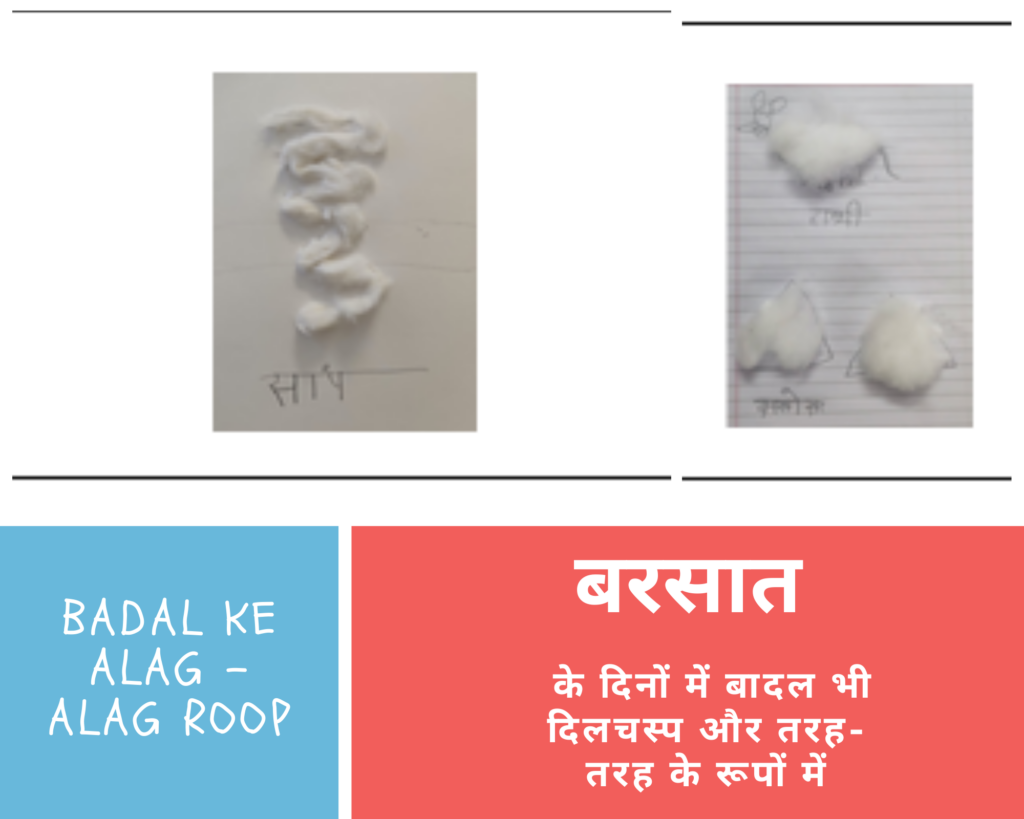 हमारे दोस्तों ने भी आसमान में बादलों की सैर की (कहानी – बादलों में देखा – फिरकी ) और बादल के तरह-तरह के रूपों को भी पहचाना और नीचे दिए गए चित्रों के माध्यम से दर्शाया:
हमारे दोस्तों ने भी आसमान में बादलों की सैर की (कहानी – बादलों में देखा – फिरकी ) और बादल के तरह-तरह के रूपों को भी पहचाना और नीचे दिए गए चित्रों के माध्यम से दर्शाया:
बरसात के दिनों जब बूँदें गिरती है तब वो हमें कहीं-कहीं पर अटकी हुई नज़र भी आती हैं | लेकिन कहाँ ? तारों में, कपड़े टाँगने वाली रस्सी पर और न जाने कहाँ-कहाँ | साथ ही साथ यह बूँदें अटकी कैसे होंगी और वे नीचे क्यों नहीं गिरती, इस बात पर आपने भी कभी सोचा है ? हमारे दोस्तों ने इन मज़ेदार सवालों के अवलोकन को ध्यान में रखते हुए “बूँदें अटकी – इकतारा” कविता पर भी कार्य किया और इस कविता का खूब आनंद लिया | बरसात में भीगने से बचने के लिए छाते का होना ज़रूरी हो जाता है | हम सभी ने “लाल छतरी – तूलिका” कहानी के माध्यम से तरह-तरह के जानवरों को छाते में आते हुए पढ़ा और कहानी के अंत में उस छाते को उड़ते हुए भी देखा | बहुत बार ऐसा भी होता है कि हमारे पास छाता तो एक है लेकिन उसमें आने वाले लोग ज़्यादा हो जाते हैं | इस परिस्तिथि में हम किस-किस को अपने छाते के अंदर बुलाना चाहेंगे ? आओ जानते हैं नीचे दिए गए कुछ चित्रों के द्वारा :
हम सभी ने “लाल छतरी – तूलिका” कहानी के माध्यम से तरह-तरह के जानवरों को छाते में आते हुए पढ़ा और कहानी के अंत में उस छाते को उड़ते हुए भी देखा | बहुत बार ऐसा भी होता है कि हमारे पास छाता तो एक है लेकिन उसमें आने वाले लोग ज़्यादा हो जाते हैं | इस परिस्तिथि में हम किस-किस को अपने छाते के अंदर बुलाना चाहेंगे ? आओ जानते हैं नीचे दिए गए कुछ चित्रों के द्वारा :
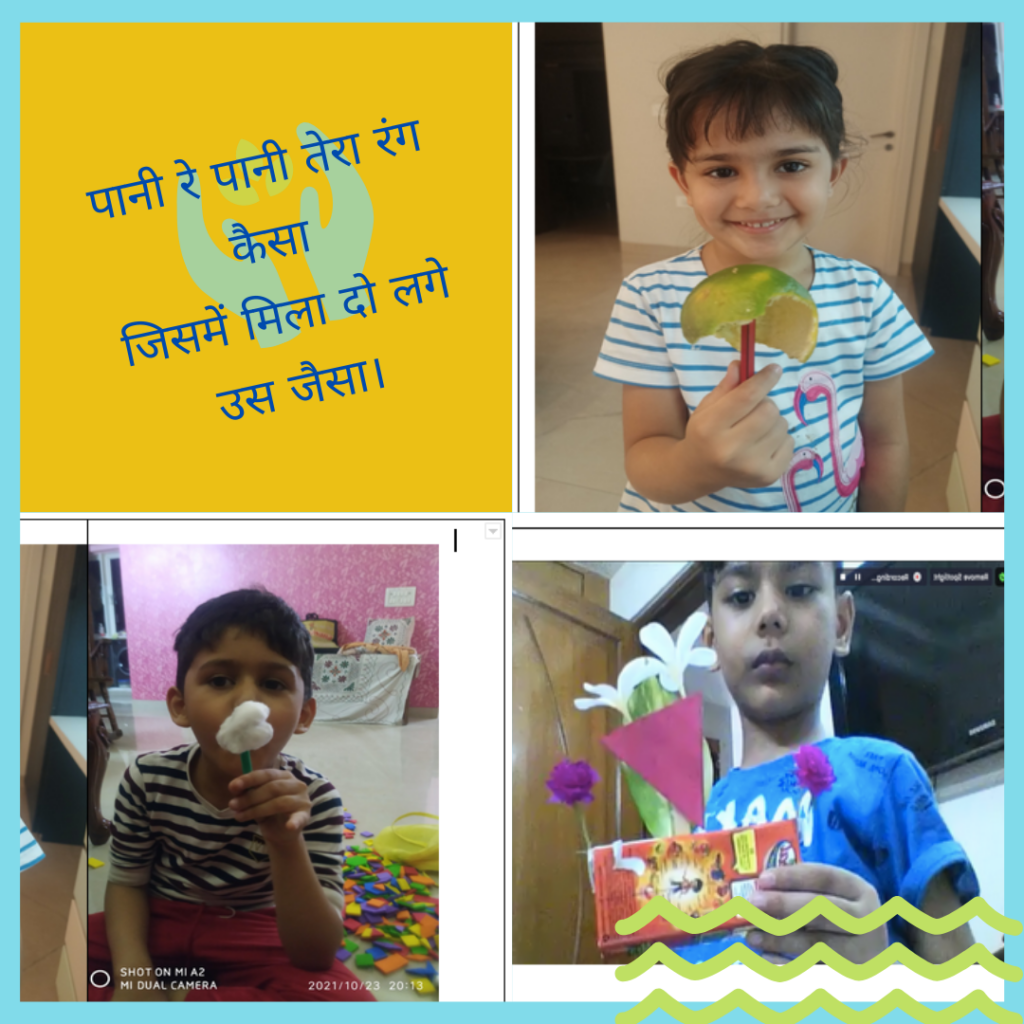 ज़रूरी नहीं हम वही छतरी को काम में लें जो हमें बज़ार से मिलती हो | कभी ऐसा भी हो सकता है कि हमें अपने आस-पास की चीज़ों से छाता तैयार करना हो, जैसे कि “छुन-छुन की छतरी” प्रथम – कहानी में भी हुआ था |
ज़रूरी नहीं हम वही छतरी को काम में लें जो हमें बज़ार से मिलती हो | कभी ऐसा भी हो सकता है कि हमें अपने आस-पास की चीज़ों से छाता तैयार करना हो, जैसे कि “छुन-छुन की छतरी” प्रथम – कहानी में भी हुआ था | हमारे दोस्त नीचे दिए गए चित्रों की मदद से आपको कुछ उपाय देना चाहेंगे :
हमारे दोस्त नीचे दिए गए चित्रों की मदद से आपको कुछ उपाय देना चाहेंगे :
आपने कभी बारिश को पकड़ने की कोशिश की है ? या फिर वह पानी जो कहीं से टपक रहा हो या बह रहा हो | कैसे? हमारे दोस्तों ने इन मज़ेदार तरीकों से बारिश को पकड़ा और “चलो ! बारिश पकड़ें – तूलिका” कहानी का आनंद लिया |
कार्य को आगे बढ़ाते हुए दोस्तों ने अपनी स्वयं की किताब की भी रचना की, जिसके लेखक और चित्रकार वे खुद थे|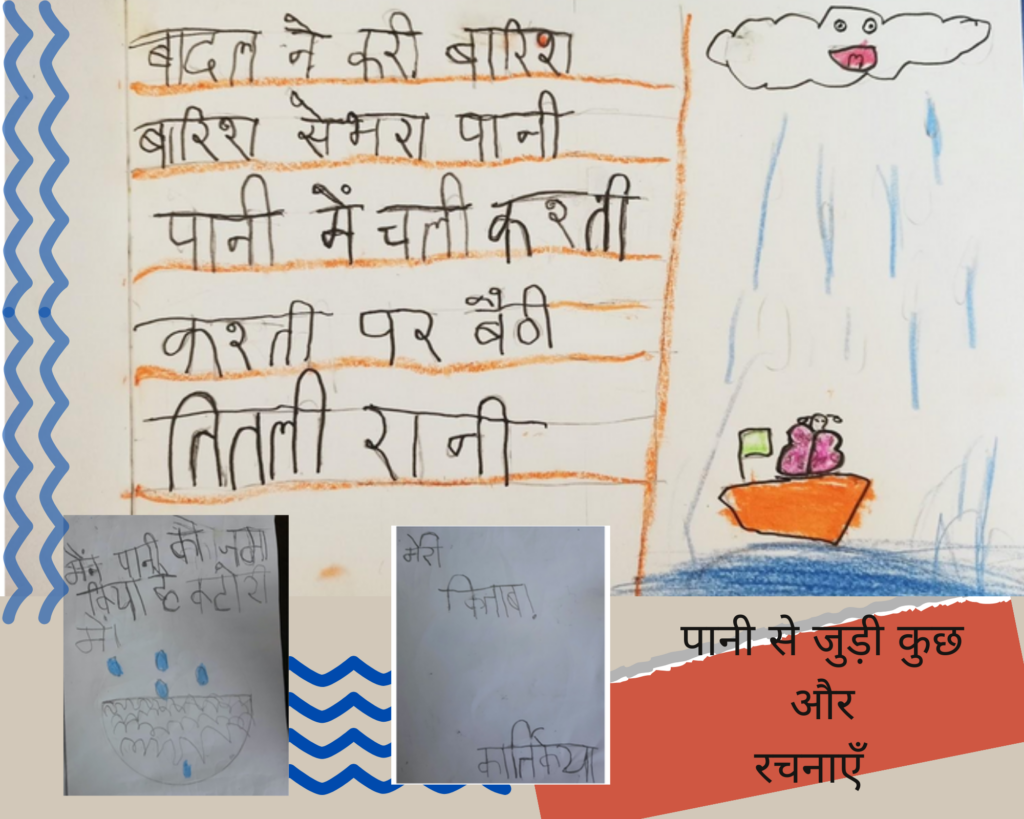 कहानी के माध्यम से उन्होंने बताया कि वे पानी को किसमें जमा करना पसंद करेंगे और उस जमा किए हुए पानी को कहाँ उपयोग में भी लाएंगे | इसके अलावा हम सभी ने मिलकर चार सामूहिक कहानियों की भी रचना की |
कहानी के माध्यम से उन्होंने बताया कि वे पानी को किसमें जमा करना पसंद करेंगे और उस जमा किए हुए पानी को कहाँ उपयोग में भी लाएंगे | इसके अलावा हम सभी ने मिलकर चार सामूहिक कहानियों की भी रचना की |
“चाँद की रोटी” – इकतारा कविता में चाँद की एक रोटी पानी में आ जाती है और उसी पानी में जो मछली होती है वह फिर भी उस रोटी को नहीं खा पाती | क्या आपने भी देखी है ऐसी ख़ास रोटी ?
हमारे मेर्री ग्रुप के दोस्तों ने इस कविता को आगे बढ़ाते हुए कुछ उपाय दिए, जैसे कि : मछली फिर गई अपने दोस्तों के पास और लग गई खेलने; मछली ने अपने दोस्तों से बातें की कि यह रोटी है क्या चीज़; मछली ने ज़ोर से रोटी पर छलांग लगाई और रोटी थोड़ी डगमगाई; और अगर मछली रोटी खा न पाई तो शायद वह रोटी परछाई है ?
अंत में, पानी के आस-पास इतनी कविताएं और कहानियां करने के बाद हम सभी ने यह जानने की कोशिश की कि पानी गीला क्यों होता है ? मेर्री ग्रुप के दोस्तों ने साझा किया कि, क्यूंकि – बादल गीले होते हैं, इसलिए; क्यूंकि पानी liquid होता है, इसलिए; क्यूंकि पानी नेचर से आया है और नेचर गीला होता है, इसलिए; क्यूंकि आसमान गीला होता है, इसलिए; क्यूंकि पानी ठोस नहीं है और न ही पानी रुई के जैसा मुलायम है, पानी तो बीच का है, इसलिए; क्यूंकि पानी पतला होता है, इसलिए और भी अनेक-अनेक रोचक कारणों की वजह से पानी गीला होता है |
During the Art sessions, we took inspiration from water to learn more about it through self expression. Learners were encouraged to imagine themselves underwater and created their underwater portraits with details as wide as their imaginations! They also got an opportunity to make their own boats and when they came to school for the first time, they went on a pond hunt which looked similar to their drawing of water lilies and other flora.They floated their boats in the pond and it was a joyous experience for all. Learners also created their own windmills and played with them. Learners made their posters to spread the message of saving water. To give them an exposure of marine life, learners created their waterfall and various water creatures which are magically visible in the light beam.
